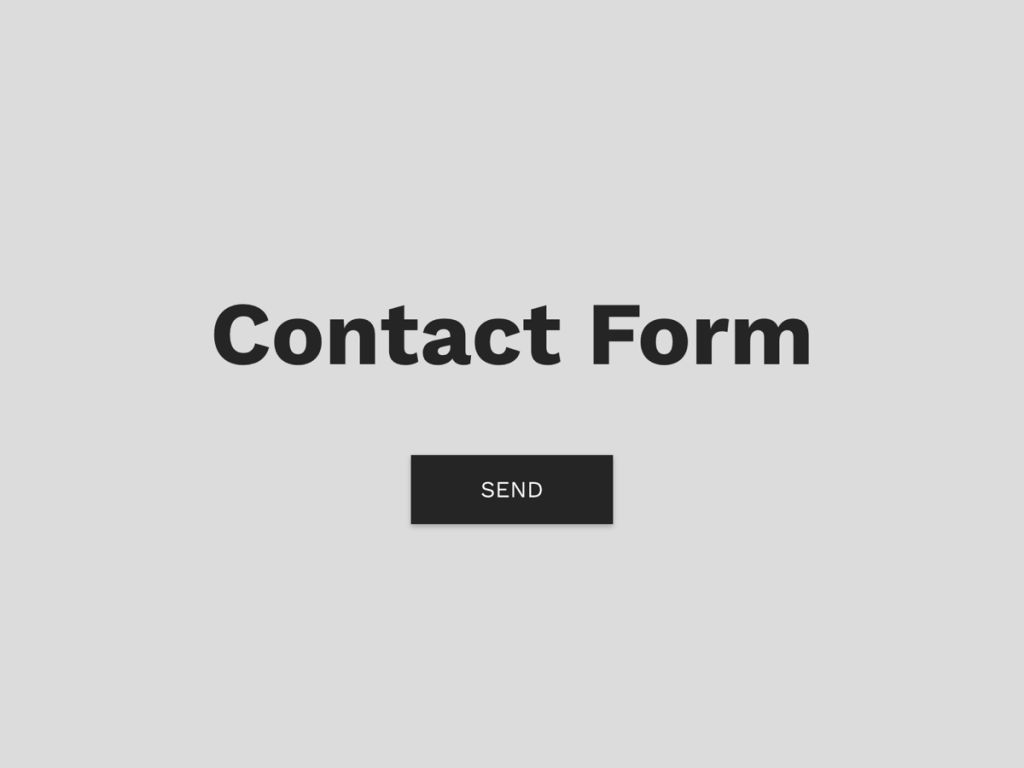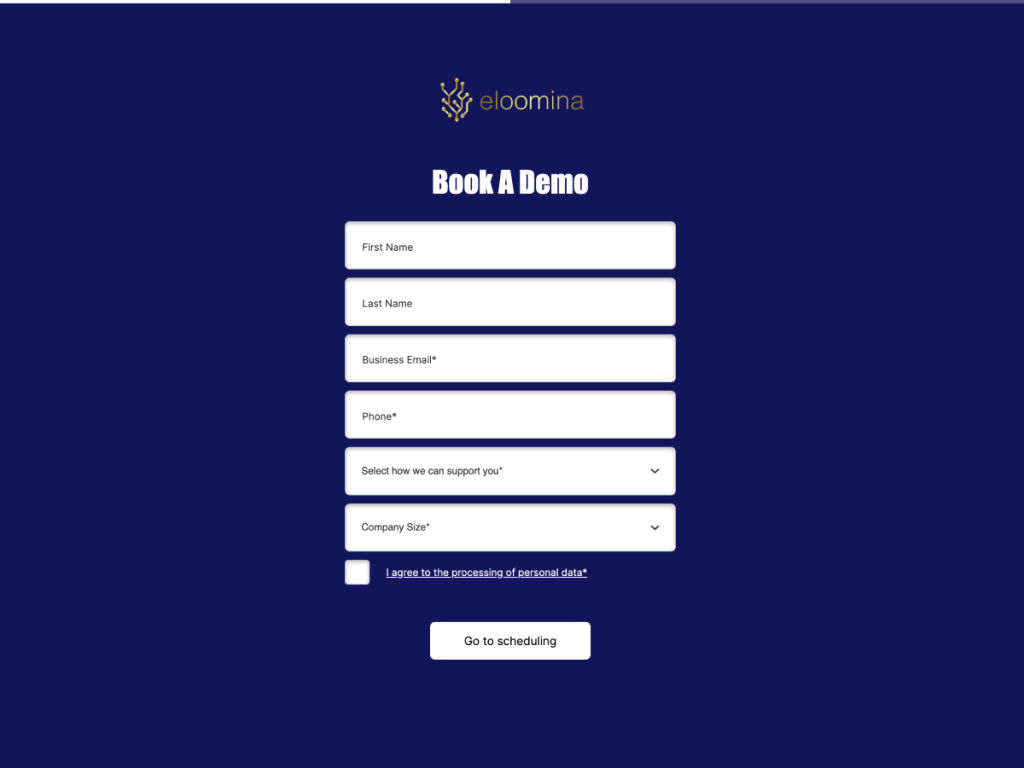Whether you're collecting feedback, running a survey, or collaborating on a quiz, knowing how to share Google Forms the right way is essential. This guide will walk you through everything you need to know, from sharing with respondents to giving edit access to collaborators, and even distributing form results efficiently.
So, how do you share a Google Form? There are several methods depending on your goals. You can send it by email, generate a Google Form send link, embed it on a website, or even share it through social media. If you're working in a team, you'll also learn how to invite collaborators and manage permissions effectively.
Not only that, but we’ll also show you how to share Google Forms responses using tools like Google Sheets or automated add-ons like Form Publisher Google Forms.
Let’s dive in and explore the smartest ways to share a Google Form, without losing control over your content.
Why Share a Google Form?
There are many practical reasons why you might need to share a Google Form, and each one has its own ideal sharing method. Let’s break down the key motivations:
Collect Responses from Users
One of the most common reasons to share Google Forms with others is to gather information via surveys, polls, feedback forms, event registrations, or quizzes. By distributing your form using a Google Form send link, email, or social media, you can reach your audience quickly and start collecting actionable data.
Collaborate with Team Members
Need help creating or managing your form? You can collaborate on Google Forms by inviting coworkers to edit the form structure, questions, and branding. So, if you're working on an HR job application form, a marketing quiz, or a customer feedback survey, shared editing access helps speed up the workflow and ensures alignment across the team.
View and Share Results with Stakeholders
Once responses start coming in, you’ll want to analyze and share them. Fortunately, you can share Google Form responses by linking your form to a Google Sheet or turning on email notifications. From there, you can easily share results with clients, managers, or other departments, while keeping control over who can view or edit the data.
Automate Feedback Workflows
Want to level up your response management? Tools like Form Publisher Google Forms allow you to automatically convert submissions into documents (PDFs, Google Docs), send response summaries via email, and even trigger approvals or follow-ups. These types of add-ons transform your form into a complete feedback automation system.
Method 1 – Share a Google Form with Respondents (No Edit Rights)
Want to share Google Form without editing access? This is the most common method for collecting submissions from users. Here's how to share a Google Form with respondents:
Option 1 – Send Google Form Via Email
Click “Send” in the top-right corner of the form editor.
Select the Email tab (default).
Enter the email addresses of your recipients.
(Optional) Tick the “Include form in email” box to embed it directly.
Click “Send.”
This is perfect when you want to send Google Form via email to a mailing list or team.

Option 2 – Share Google Form Send Link
Click “Send” > Click the Link icon (chain symbol).
(Optional) Enable “Shorten URL” to get a compact version.
Copy and paste the link into chats, documents, or social platforms.
This method is ideal for quickly generating a Google Form send link to distribute manually.
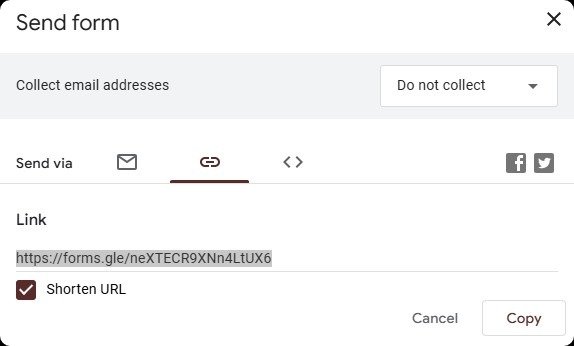
Option 3 – Embed Google Form on a Website
Click “Send” > Select the Embed tab (<> icon).
Copy the HTML iframe code.
Customize the height and width as needed.
Paste into your CMS or website builder.
This is how you embed Google Form on your blog or site for a seamless UX.
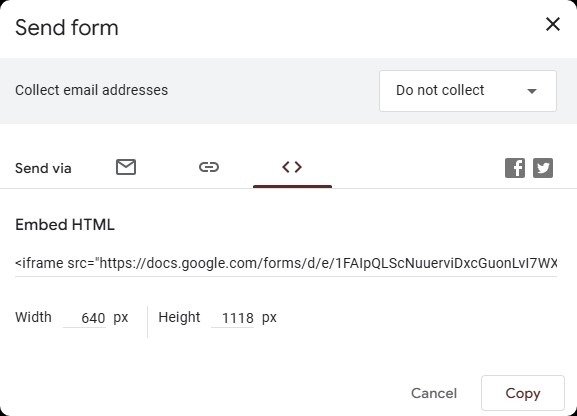
Option 4 – Share Via Social Media
Click “Send” > Select Facebook or Twitter tabs.
Add a custom message if desired.
Share directly from Google Forms.
Perfect for marketing teams sharing surveys with large social followings.

Method 2 – How Do You Share a Google Form with Editors (Collaborators)
Need help building or managing a form? Here’s how to collaborate on Google Forms by adding editors.
How to Add Google Form Collaborators
Open your form.
Click the three-dot menu in the top-right corner.
Select “Add collaborators.”
Enter email addresses of your team.
Set permissions – they can edit form and view responses.
(Optional) Add a message and notify collaborators.
This is the simplest way to add Google Form collaborators to streamline form building.

Collaborator Permissions Explained
Can edit form questions and design.
Can view collected responses.
Cannot transfer ownership unless the owner changes it manually.
Be cautious with whom you grant edit access, only share with trusted collaborators.
Method 3 – Share Google Form Responses
Finished collecting responses? Here's how to share Google Forms responses with stakeholders or team members.
Link Form to Google Sheets
Open your form and go to the “Responses” tab.
Click the green Sheets icon.
Choose to create a new Sheet or link to an existing one.
This allows real-time syncing of all submissions into a spreadsheet.
Share the Linked Google Sheet
Open the linked Google Sheet.
Click the blue “Share” button.
Choose access level: View, Comment, or Edit.
(Optional) Generate a shareable link or invite people directly.
Now you can securely share results with different access levels depending on the audience.

Share Individual Responses Via Email
Enable email notifications for new responses.
Forward individual responses as needed.
Great for quick sharing without giving full spreadsheet access.
Bonus – Automate Response Sharing with Form Publisher Google Forms Add-on
Looking to automate your form workflows? Tools like Form Publisher can transform how to share Google Forms responses.
With Form Publisher Google Forms, you can:
Automatically send personalized PDFs or Docs of each submission.
Create workflows for document approvals.
Distribute submissions to different stakeholders.
Ensure compatibility with Google Workspace.

Other automation alternatives:
Zapier – Automate workflows across multiple apps.
Make (Integromat) – Advanced conditional flows.
Google Apps Script – Custom solutions for dev teams.
Sharing Online Forms Using involve.me (We Made It Easy)
While Google Forms is a popular tool, it comes with limitations, especially when you're scaling your business, need more customization, or want advanced form sharing workflows. That’s where involve.me comes in.
Why involve.me Beats Google Forms for Sharing Online Forms
involve.me is a no-code platform built for businesses that need high-converting, personalized, and visually on-brand funnels, forms, quizzes, surveys, and calculators. Unlike Google Forms, which offers static layouts and basic sharing, involve.me empowers you with dynamic sharing options tailored for marketing, sales, HR, and customer success.
Here’s how involve.me makes sharing forms easier, more powerful, and more professional:
1. One-Click Sharing with Smart Links
Every form you create in involve.me can be shared instantly via:
Direct URL Sharing: After publishing your form, you can share it via a direct link, which can be customized to match your branding
Short URLs and QR Codes: For quick access, involve.me generates short URLs and QR codes linked to your forms, making it easy to share them in print materials or presentations.
Email Invitations: You can send personalized email invitations directly from involve.me to your contacts, inviting them to participate in your form.
Social Media Sharing: Share your forms directly on platforms like Facebook and LinkedIn to reach a broader audience.
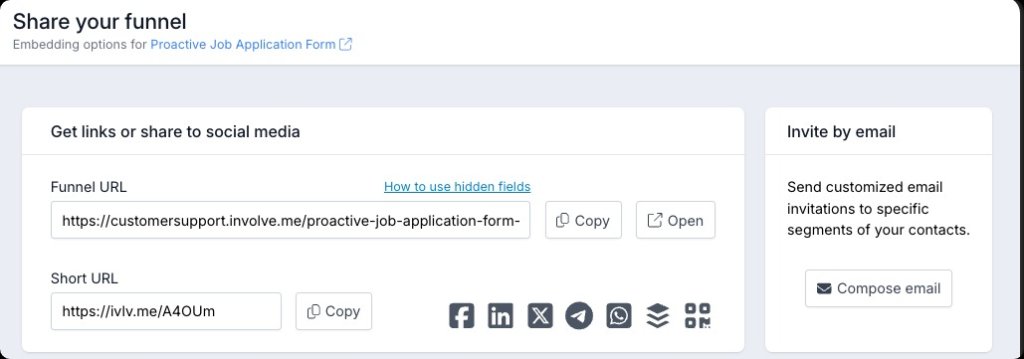
2. Branded & Embedded Forms That Convert
Tired of generic-looking forms? With involve.me, your shared forms:
Are fully brandable (fonts, colors, logos, animations)
Can be embedded into websites, blogs, and product pages with responsive design
Offer conditional flows that personalize each user’s experience
Support multi-step formats to keep users engaged and improve conversions
3. Advanced Embedding Options
Unlike Google Forms, which offers limited embedding options, involve.me provides multiple embedding methods to seamlessly integrate forms into your website:
Standard Embed: Embed your form directly into a webpage using a responsive iframe. You can customize the height, width, and background to match your site's design.
Full-Page Embed: Display your form as a full-page experience, ideal for standalone landing pages.
Pop-Up Embed: Add your form as a pop-up on your website, with various trigger options such as:
On Button Click: The form appears when a user clicks a designated button.
On Page Load: The form automatically appears when the page loads.
After Time Delay: Set a specific time delay after which the form appears.
On Exit Intent: The form appears when the user attempts to leave the page.
Chat Button, Side Panel, and Side Tab: These options allow the form to appear in various interactive formats, enhancing user engagement.
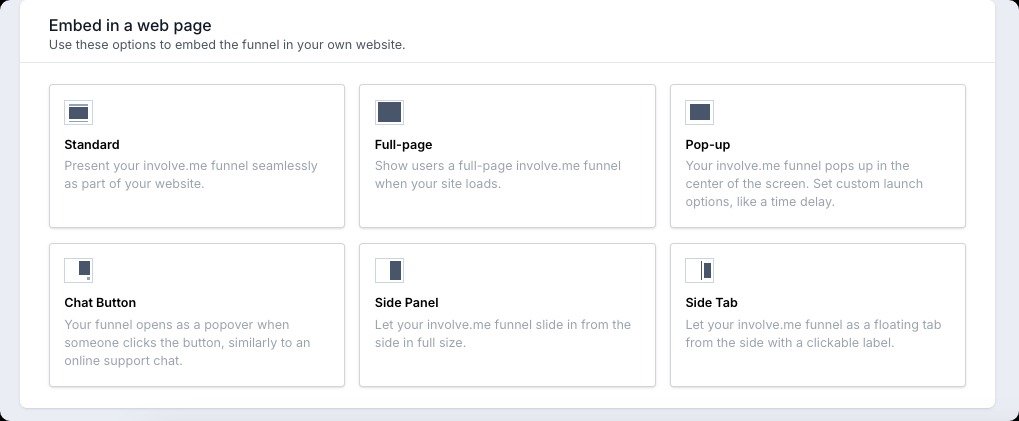
4. Enhanced Customization and User Experience
involve.me offers extensive customization options to ensure your forms align with your brand and provide a superior user experience:
Design Customization: Adjust colors, fonts, and layouts to match your branding.
Dynamic Height Resize: The embedded form can automatically adjust its height based on content, ensuring a seamless fit within your webpage.
Transparent Backgrounds and Loading Colors: Customize the form's background and loading colors to blend seamlessly with your site's aesthetics.
Hidden Fields and URL Parameters: Pass data through URL parameters to pre-fill form fields, enhancing personalization and tracking.

5. Collaborate Without Chaos
Unlike Google Forms’ limited collaboration model, involve.me offers structured, role-based teamwork across multiple workspaces.
Invite team members as Editors or Viewers to specific workspaces, perfect for agencies, HR, or marketing teams.
Editors can create, edit, publish, and manage funnels; Viewers can only access forms and analytics.
One person can have different roles across workspaces (e.g., Editor in Marketing, Viewer in HR).
Manage team seats easily, pending invitations also count as active seats.
Remove or update access with just a few clicks from the workspace settings.
6. Share Results with Smart Automation
Where Google Forms needs manual integration with Sheets or third-party add-ons, involve.me lets you:
Automatically send form responses to email, Slack, Google Sheets, or your CRM
Trigger follow-up actions based on responses (e.g., send a lead magnet, book a meeting, notify sales)
Visualize analytics through built-in dashboards
Export data as PDFs, CSV, or to tools like HubSpot, Mailchimp, and Salesforce

Create and embed your online forms
Use from 300+ Templates
Common Mistakes to Avoid When Sharing a Google Form
Even though it’s simple to share Google Forms with others, it's just as easy to make mistakes that compromise privacy, confuse collaborators, or block access to important responses. Before you hit "Send," watch out for these common missteps:
Accidentally Sharing Edit Access with Respondents
One of the most frequent (and most damaging) mistakes is sharing Google Form without editing restrictions. If you send a form link with full access permissions, respondents can accidentally, or intentionally, change form questions, modify options, or even delete existing content.
Best practice: Always use the “Send” button for respondent sharing instead of the “Add collaborators” option. This ensures users only have view and submit access, not edit rights. When in doubt, double-check permissions by clicking the three-dot menu > Add collaborators and ensuring the right people have access to edit, and only them.
Forgetting to Shorten Long Links Before Sharing
Long, messy URLs can look unprofessional and may get cut off when pasted into emails or chats. Plus, they’re not ideal for sharing on social media or printed materials.
If you're using the Google Form send link option, always check the “Shorten URL” box to create a cleaner, more shareable version. This also helps reduce link-breaking issues across platforms.
Bonus tip: If you’re using involve.me, short, branded URLs are generated automatically, so you never have to worry about this step.
Not Reviewing Google Sheet Sharing Settings
Once you link a form to Google Sheets to view or analyze responses, don’t forget that the Sheet has its own separate sharing permissions. Many users mistakenly assume that sharing the form automatically gives access to the linked Sheet, it doesn’t.
If you need to share Google Form responses with stakeholders via Sheets, make sure to open the Sheet and click the “Share” button. From there, assign appropriate permissions: Viewer, Commenter, or Editor, depending on your use case.
Tip: Avoid giving edit access to large groups. Stick to “View only” unless someone truly needs to modify the spreadsheet.
Assuming Collaborators Can See Responses Without Linking Sheets
When you collaborate on Google Forms, added editors can update questions and design, but they don’t automatically see individual responses unless you manually link the form to a Sheet or grant them access to email notifications.
If you're working with a team and want everyone to review submissions, link the form to Google Sheets and share that document directly. You can also turn on “Email notifications for new responses” and add collaborators to the recipient list.
Important: This limitation is often overlooked, causing confusion and delays in feedback workflows.
FAQs – How to Share Google Forms Link
Can I share a form without giving edit access?
Yes, use the link, email, or embed options under the “Send” button.How do I send a form to multiple people at once?
Use the Email tab in “Send” or share a public link.Can people without Gmail access the form?
Yes, if “Restrict to users in your org” is disabled.How do I share results without exposing emails?
Use the Google Sheet summary view or clean data manually before sharing.Can I schedule form access or expiration?
Not natively, but use add-ons or Google Apps Script for this.
Final Thoughts
Knowing how to share Google Forms the right way ensures smooth collaboration, secure data collection, and effective communication with stakeholders. If you're sharing with respondents, team members, or exporting results, these best practices will serve you well.
To recap, how do you share a Google Form effectively? Use the appropriate method, email, link, embed, or collaborators, depending on the audience and your goals.
Pro Tip: Use tools like Form Publisher Google Forms to automate workflows, or try platforms like involve.me for advanced features.



